Effect of the Adaptive Response on the Wear Behavior of PVD and CVD Coated Cutting Tools during Machining with Built Up Edge Formation
Abstract
1. Introduction
- -
- The nano-scale process of tribo-film formation (a non-equilibrium process related to self-organization) caused by the indirect influence of friction [5]. This process is initiated by the surface modification of cutting tools with further interaction with the environment (tribo-oxidation), which forms protective/lubricating tribo-films [5,6]. Such processes commence abruptly and result in negative entropy production [6]. Although they are not directly related to friction, a part of friction energy is consumed during tribo-film generation, which would be otherwise spent on the wear process. As a result, the general entropy production goes down.
- -
- The micro-scale process that is a direct result of friction caused by the mechanical response of the surface engineered layer due to energy dissipation within the alternating nano-layers of the multilayered coatings [7] or within a layer of a High Entropy Alloy coating [8] or as an integrative mechanical response of the coating/carbide tool system [9]. Such processes develop gradually and also contribute to the reduction in entropy production.
2. Case Studies
2.1. Coatings That Produce Different Types of Tribo-Films during Cutting through the Adaptive Response of the Tribo-System at the Nano-Scale
2.1.1. Coatings that Create a Layer of Lubricating Tribo-Films. Machining of a Ti Alloy with Strong Built-Up Edge (BUE) Formation
2.1.2. Coatings That Create a Layer of Thermal Barrier Tribo-Films
Machining of SDSS with Intensive Built-Up Edge Formation
High Speed Machining of Ti Alloys: Combination of Built-Up Edge Formation and Cratering
2.2. Coatings That Create an Adaptive Response at the Micro-Scale through Partial Flaking of the Surface Engineered Layer
2.3. Surface Engineered Layer That Demonstrates the Adaptive Response of the Entire Coated Carbide Tool System
3. Future Research Directions for Achieving Better Control over Wear Performance during Machining with BUE Formation: Multi-Functional Coatings
3.1. Multifunctional Boride Coatings
3.2. High Entropy Alloyed Coatings (HEAC)
4. Conclusions
Author Contributions
Funding
Acknowledgments
Conflicts of Interest
References
- Dimova, E.G.; Bryant, P.E.; Chankova, S.G. Adaptive response: Some underlying mechanisms and open questions. Genet. Mol. Biol. 2008, 31, 396–408. [Google Scholar] [CrossRef]
- Landini, P.; Volkert, M.R. Regulatory Responses of the Adaptive Response to Alkylation Damage: A Simple Regulon with Complex Regulatory Features. J. Bacteriol. 2000, 182, 6543–6549. [Google Scholar] [CrossRef]
- Wang, I.; Bisoyi, H.K.; Zheng, Z.; Gutierrez-Cuevas, K.G. Stimuli-directed self-organized chiral superstructures for adaptive windows enabled by mesogen-functionalized grapheme. Mater. Today 2017, 20, 230–237. [Google Scholar] [CrossRef]
- Fox-Rabinovich, G.S.; Gershman, I.S.; Veldhuis, S. Thin-Film PVD Coating Metamaterials Exhibiting Similarities to Natural Processes under Extreme Tribological Conditions. Nanomaterials 2020, 10, 1720. [Google Scholar] [CrossRef]
- Gershman, I.S.; Gershman, E.I.; Mironov, A.E.; German, S.; Fox-Rabinovich, G.S.; Veldhuis, S.C. Application of the Self-Organization Phenomenon in the Development of Wear Resistant Materials—A Review. Entropy 2016, 18, 385. [Google Scholar] [CrossRef]
- Fox-Rabinovich, G.; Totten, G.E. Self-Organization during Friction: Advanced Surface-Engineered Materials and Systems Design; CRC Press: Boca Raton, FL, USA, 2006. [Google Scholar]
- Yau, B.-S.; Huang, J.-L.; Lu, H.-H.; Sajgalik, P. Investigation of nanocrystal-(Ti1−xAlx)Ny/amorphous-Si3N4 nanolaminate films. Surf. Coat. Technol. 2005, 194, 119. [Google Scholar] [CrossRef]
- Wang, Z.; Wang, C.; Zhao, Y.L.; Hsu, Y.C.; Li, C.L. High hardness and fatigue resistance of CoCrFeMnNi high entropy alloy films with ultrahigh-density nanotwins. Int. J. Plast. 2020, 131, 102726. [Google Scholar] [CrossRef]
- He, Q.; Paiva, J.M.; Kohlscheen, J.; Beake, B.D.; Veldhuis, S.C. An integrative approach to coating/carbide substrate design of CVD and PVD coated cutting tools during the machining of austenitic stainless steel. Ceram. Int. 2020, 46, 5149–5158. [Google Scholar] [CrossRef]
- Trent, E.M.; Wright, P.K. Metal Cutting, 4th ed.; Butterworth-Heinemann: London, UK, 2000; p. 352. [Google Scholar]
- Kabaldin, Y.G.; Kojevnikov, N.V.; Kravchuk, K.V. HSS cutting tool wear resistance study. J. Frict. Wear 1990, 11, 130–135. [Google Scholar]
- Ahmed, Y.S.; Paiva, J.M.; Bose, B.; Veldhuis, S. New observations on built-up edge structures for improving machining performance during the cutting of superduplex stainless steel. Tribol. Int. 2019, 137, 212–227. [Google Scholar] [CrossRef]
- Fox-Rabinovich, G.S.; Kovalev, A.I. Self-Organization and Structural Adaptation during Cutting and Stamping Operations. In Self-Organization during Friction: Advance Surface Engineered Materials and Systems Design; Fox-Rabinovich, G.S., Totten, G., Eds.; CRC Press, Taylor and Francis Group: Boca Raton, FL, USA, 2006; pp. 151–167. [Google Scholar]
- Feder, H.J.S.; Feder, J. Self-Organized Criticality in a Stick-Slip Process. Phys. Rev. Lett. 1991, 66, 2669–2672. [Google Scholar] [CrossRef]
- Zypman, F.; Ferrente, J.; Jansen, M.; Scanlon, K.; Abel, P. Evidence of self-organized criticality in dry sliding friction. J. Phys. Condens. Matter 2003, 15, 12. [Google Scholar] [CrossRef]
- Bak, P.; Tang, C.; Wiesenfeld, K. Self-organized criticality. Phys. Rev. A 1988, 38, 364–374. [Google Scholar] [CrossRef]
- Bak, P.; Tang, C. Earthquakes as a self-organized critical phenomenon. J. Geophys. Res. B 1989, 94, 15635–15637. [Google Scholar] [CrossRef]
- Bak, P. How Nature Works: The Science of Self-Organized Criticality; Springer: Berlin/Heidelberg, Germany, 1999; p. 155. [Google Scholar]
- Nosonovsky, M. Self-organization at the frictional interface for green tribology. Philos. Trans. R. Soc. A 2010, 368, 4755–4774. [Google Scholar] [CrossRef]
- Nosonovsky, M.; Bhushan, B. Thermodynamics of surface degradation, self-organization and self-healing for biomimetic surfaces. Philos. Trans. R. Soc. A 2009, 367, 1607–1627. [Google Scholar] [CrossRef]
- Wang, Q.; Lu, C.; Ye, G.G.; Dai, L.H. Modeling the tunned criticality in stick-slip friction during metal cutting. Model. Simul. Mater. Sci. Eng. 2015, 23, 055013. [Google Scholar] [CrossRef]
- Hoffmann, H.; Payton, D.W. Optimization by Self-organized criticality. Sci. Rep. 2018, 8, 2358. [Google Scholar] [CrossRef]
- Cajueiro, D.O.; Andrade, R.F.S. Controlling self-organized criticality in sandpile models. Phys. Rev. E 2010, 81, 015102. [Google Scholar] [CrossRef]
- Cajueiro, D.O.; Andrade, R.F.S. Controlling self-organized criticality in complex networks. Eur. Phys. J. B 2010, 77, 291–296. [Google Scholar] [CrossRef]
- Cajueiro, D.O.; Andrade, R.F.S. Dynamical programming approach for controlling the directed Abelian Dhar-Ramaswamy model. Phys. Rev. E 2010, 82, 031108. [Google Scholar] [CrossRef]
- Fox-Rabinovich, G.S.; Yamamoto, K.; Beake, B.D.; Gershman, I.S.; Kovalev, A.I.; Aguirre, M.H.; Veldhuis, S.C.; Dosbaeva, G.; Endrino, J.L. Hierarchical adaptive nano-structured PVD coatings for extreme tribological applications: The quest for non-equilibrium states and emergent behavior. Sci. Technol. Adv. Mater. 2012, 13, 043001. [Google Scholar] [CrossRef] [PubMed]
- Beake, B.D.; Fox-Rabinovich, G.S.; Losset, Y.; Yamamoto, K.; Agguire, M.H.; Veldhuis, S.C.; Endrino, J.L.; Kovalev, A.I. Why can TiAlCrSiYN-based adaptive coatings deliver exceptional performance under extreme frictional conditions? Faraday Discuss. 2012, 156, 1–11. [Google Scholar] [CrossRef] [PubMed]
- Chowdhury, M.S.I.; Chowdhury, S.; Yamamoto, K.; Beake, B.D.; Bose, B.; Elfizy, A.; Covelli, D.; Dosbaeva, G.; Aramesh, M.; Fox-Rabinovich, G.S.; et al. Wear behavior of coated carbide tools during machining of Ti6Al4V aerospace alloy associated with strong built-up edge formation. Surf. Coat. Technol. 2017, 313, 319–327. [Google Scholar] [CrossRef]
- Prigogine, I. Time, Structure, and Fluctuations. Science 1978, 1, 777–785. [Google Scholar] [CrossRef]
- Oddershede, L.; Dimon, P.; Bohr, J. Self-organized criticality in fragmenting. Phys. Rev. Lett. 1993, 71, 3107. [Google Scholar] [CrossRef]
- Fox-Rabinovich, G.; Paiva, J.M.; Gershman, I.; Aramesh, M.; Covelli, D.; Yamamoto, K.; Dosbaeva, G.; Veldhuis, S. Control of Self-Organized Criticality through Adaptive Behavior of Nano-Structured Thin Film Coatings. Entropy 2016, 18, 290. [Google Scholar] [CrossRef]
- Abdoos, M.; Yamamoto, K.; Bose, B.; Fox-Rabinovich, G.; Veldhuis, S. Effect of coating thickness on the tool wear performance of low-stress TiAlN PVD coating during turning of compacted graphite iron (CGI). Wear 2019, 422, 128–136. [Google Scholar] [CrossRef]
- Mitterer, C. Borides in Thin Film Technology. J. Solid State Chem. 1997, 133, 279–291. [Google Scholar] [CrossRef]
- Aouadi, S.M. Lubricious oxide coatings for extreme temperature applications: A review. Surf. Coat. Technol. 2014, 257, 266–277. [Google Scholar] [CrossRef]
- Mackenzie, J.D.; Claussen, W.F. Crystallization and Phase Relations of Boron Trioxide at High Pressures. J. Am. Ceram. Soc. 1961, 44, 79–81. [Google Scholar] [CrossRef]
- Chowdhury, M.S.I.; Bose, B.; Yamamoto, K.; Shuster, L.S.; Paiva, J.; Fox-Rabinovich, G.S.; Veldhuis, S.C. Wear performance investigation of PVD coated and uncoated carbide tools during high-speed machining of TiAl6V4 aerospace alloy. Wear 2020, 446, 203168. [Google Scholar] [CrossRef]
- Fox-Rabinovich, G.S.; Beake, B.D.; Yamamoto, K.; Aguirre, M.H.; Veldhuis, S.C.; Dosbaeva, G.; Elfizy, A.; Biksa, A.; Shuster, L.S. Structure, properties and wear performance of nano-multilayered TiAlCrSiYN/TiAlCrN coatings during machining of Ni-based aerospace superalloys. Surf. Coat. Technol. 2010, 204, 3698–3706. [Google Scholar] [CrossRef]
- Fox-Rabinovich, G.; Kovalev, A.; Veldhuis, S.; Yamamoto, K.; Endrino, J.L.; Gershman, I.S.; Rashkovskiy, A.; Aguirre, M.H.; Wainstein, D.L. Spatio-Temporal Behavior of Atomic-Scale Tribo-Ceramic Films in Adaptive Surface Engineered Nano-Materials; Nature Publishing Group: London, UK, 2015. [Google Scholar] [CrossRef]
- Yuan, J.; Yamamoto, K.; Covelli, D.; Tauhiduzzaman, M.; Arif, T.; Gershman, I.; Veldhuis, S.; Fox-Rabinovich, G. Tribo-films control in adaptive TiAlCrSiYN/TiAlCrN multilayer PVD coating by accelerating the initial machining conditions. Surf. Coat. Technol. 2016, 294, 54–61. [Google Scholar] [CrossRef]
- Paiva, J.M.; Shalaby, M.A.M.; Chowdhury, M.; Shuster, L.; Chertovskikh, S.; Covelli, D.; Junior, E.L.; Stolf, P.; Elfizy, A.; Bork, C.A.S.; et al. Tribological and wear performance of carbide tools with TiB2 PVD coating under varying machining conditions of TiAl6V4 aerospace alloy. Coatings 2017, 7, 187. [Google Scholar] [CrossRef]
- Lupicka, O.; Warcholinski, B. The adhesion of CrN thin films deposited on modified 42CrMo4 steel. Ann. Mater. Sci. Eng. 2017, 2017, 4064208. [Google Scholar] [CrossRef]
- Milosev, I.; Strehblow, H.H.; Navinsek, B. Comparison of TiN, ZrN, and CrN coatings under oxidation. Thin Solid Films 1997, 303, 246–254. [Google Scholar] [CrossRef]
- Berg, G.; Friedrich, C.; Broszeit, E.; Berger, C. Development of chromium nitride coatings substituting titanium nitride. Surf. Coat. Technol. 1996, 86, 184–191. [Google Scholar] [CrossRef]
- Sato, T.; Tada, O.; Hoke, K.; Besshi, T. A crossed-cylinders testing for evaluation of wear and tribological properties of coated tools. Wear 1994, 178, 95–100. [Google Scholar] [CrossRef]
- Navinsek, B.; Panjan, P.; Milosev, I. PVD coatings as an environmentally clean alternative to electroplating and electroless processes. Surf. Coat. Technol. 1999, 116, 476–487. [Google Scholar] [CrossRef]
- Bertrand, G.; Mahdjoub, H.; Meunier, C. A study of the corrosion behaviour and protective quality of sputtered chromium nitride coatings. Surf. Coat. Technol. 2000, 126, 199–209. [Google Scholar] [CrossRef]
- Hatt, O.; Crawforth, P.; Jackson, M. On the mechanism of tool crater wear during titanium alloy machining. Wear 2017, 15–20. [Google Scholar] [CrossRef]
- Kramer, A.; Bignardi, L.; Lacovig, P.; Lizzit, S.; Batzill, M. Comparison of surface structures of corundum Cr2O3 (0 0 0 1) and V2O3 (0 0 0 1) ultrathin films by x-ray photoelectron diffraction. J. Phys. Condens. Matter 2018, 30, 74002. [Google Scholar] [CrossRef] [PubMed]
- Wang, D.Y.; Lin, J.H.; Ho, W.Y. Study on chromium oxide synthesized by unbalanced magnetron sputtering. Thin Solid Films 1998, 332, 295–299. [Google Scholar] [CrossRef]
- Taylor, R.E. Thermal conductivity of titanium carbide at high temperatures. J. Am. Ceram. Soc. 1961, 44, 525. [Google Scholar] [CrossRef]
- Holmberg, K.; Laukkanen, A.; Ronkainen, H.; Wallin, K.; Varjus, S. A model for stresses, crack generation and fracture toughness calculation in scratched TiN-coated steel surfaces. Wear 2003, 254, 278–291. [Google Scholar] [CrossRef]
- Sebastiani, M.; Johanns, K.E.; Herbert, E.G. Measurement of fracture toughness by nanoindentation methods: Recent advances and future challenges. Curr. Opin. Solid State Mater. Sci. 2015, 19, 324–333. [Google Scholar] [CrossRef]
- Ast, J.; Ghidelli, M.; Durst, K.; Göken, M.; Sebastiani, M.; Korsunsky, A.M. A review of experimental approaches to fracture toughness evaluation at the micro-scale. Mater. Des. 2019, 173, 107762. [Google Scholar] [CrossRef]
- Fox-Rabinovich, G.S.; Veldhuis, S.C.; Skvortsov, V.N.; Shuster, L.S.H.; Dosbaeva, G.K.; Migranov, M.S. Elastic and plastic work of indentation as a characteristic of wear behavior for cutting tools with nitride PVD coatings. Thin Solid Films 2004, 469, 505–512. [Google Scholar] [CrossRef]
- Kathrein, M.; Michotte, C.; Penoy, M.; Polcik, P.; Mitterer, C. Multifunctional multi-component PVD coatings for cutting tools. Surf. Coat. Technol. 2005, 200, 1867–1871. [Google Scholar] [CrossRef]
- Hale, T.; Lueth, R. Boride Coated Cemented Carbide. U.S. Patent US4268582A 19 May 1981. [Google Scholar]
- Dearnley, P.; Schellewald, M.; Dahm, K. Characterisation and wear response of metal-boride coated WC–Co. Wear 2005, 259, 861–869. [Google Scholar] [CrossRef]
- Choi, H.S.; Park, B.; Lee, J.J. CrB2 coatings deposited by inductively coupled plasma assisted DC magnetron sputtering. Surf. Coat. Technol. 2007, 202, 982–986. [Google Scholar] [CrossRef]
- Bedse, R.D.; Sonber, J.K.; Sairam, K.; Murthy, T.S.R.; Hubli, R.C. Processing and Characterization of CrB2-Based Novel Composites. High Temp. Mater. Proc. 2015, 34, 683–687. [Google Scholar]
- Audronis, M.; Kelly, P.J.; Arnell, R.D.; Valiulis, A.V. Pulsed magnetron sputtering of chromium boride films from loose powder targets. Surf. Coat. Technol. 2006, 200, 4166–4173. [Google Scholar] [CrossRef]
- Audronis, M.; Kelly, P.J.; Arnell, R.D.; Leyland, A.; Matthews, A. Deposition of ulticomponent chromium boride-based coatings by pulsed magnetron sputtering of powder targets. Surf. Coat. Technol. 2005, 200, 1616–1623. [Google Scholar] [CrossRef]
- Kiryukhantsev-Korneev, P.V.; Horwat, D.; Pierson, J.F.; Levashov, E.A. Comparative Analysis of Cr–B Coatings Deposited by Magnetron Sputtering in DC and HIPIMS Modes. Tech. Phys. Lett. 2014, 40, 614–617. [Google Scholar] [CrossRef]
- Gao, M.C.; Yeh, J.; Liaw, P.; Zhang, Y. High-Entropy Alloys. Fundamentals and Applications; Springer: Berlin/Heidelberg, Germany, 2016. [Google Scholar]
- Hsieh, M.-H.; Tsai, M.-H.; Shen, W.-J.; Yeh, J.-W. Structure and properties of two Al–Cr–Nb–Si–Ti high-entropy nitride coatings. Surf. Coat. Technol. 2013, 221, 118–123. [Google Scholar] [CrossRef]
- Mayrhofer, P.H.; Kirnbauer, A.; Ertelthaler, P.H.; Koller, C.M. High-entropy ceramic thin films: A case study on transition metal diborides. Scr. Mater. 2018, 149, 93–97. [Google Scholar] [CrossRef]
- Pogrebnjak, A.D.; Bagdasaryan, A.A.; Yakushchenko, I.V.; Beresnev, V.M. The structure and properties of high-entropy alloys and nitride coatings based on them. Russ. Chem. Rev. 2014, 83, 1027–1106. [Google Scholar] [CrossRef]
- Lai, C.H.; Cheng, K.H.; Lin, S.J.; Yeh, J.W. Mechanical and tribological properties of multi-element. Surf. Coat. Technol. 2008, 202, 3732–3738. [Google Scholar] [CrossRef]
- Lai, C.H.; Lin, S.J.; Yeh, J.W.; Davison, A. Effect of substrate bias on the structure and properties of multi-element (AlCrTaTiZr)N coatings. J. Phys. D Appl. Phys. 2006, 39, 4628–4633. [Google Scholar] [CrossRef]
- Lin, C.H.; Duh, J.G.; Yeh, J.W. Multi-component nitride coatings derived from Ti-Al-Cr-Si-V target in rf magnetron sputter. Surf. Coat. Technol. 2007, 201, 6304–6308. [Google Scholar] [CrossRef]
- Chang, H.W.; Huang, P.K.; Yeh, J.W.; Davison, A.; Tsau, C.H.; Yang, C.C. Influence of substrate bias, deposition temperature and post-deposition annealing on the structure and properties of multi-principal-component (AlCrMoSiTi)N coatings. Surf. Coat. Technol. 2008, 202, 3360–3366. [Google Scholar] [CrossRef]
- Tsai, M.H.; Lai, C.H.; Yeh, J.W.; Gan, J.Y. Effects of nitrogen flow ratio on the structure and properties of reactively sputtered (AlMoNbSiTaTiVZr)Nx coatings. J. Phys. D Appl. Phys. 2008, 41. [Google Scholar] [CrossRef]
- Tsai, D.C.; Chang, Z.C.; Kuo, L.Y.; Lin, T.J.; Lin, T.N.; Shieu, F.S. Solid solution coating of (TiVCrZrHf)N with unusual structural evolution. Surf. Coat. Technol. 2013, 217, 84–87. [Google Scholar] [CrossRef]
- Braic, V.; Vladescu, A.; Balaceanu, M.; Luculescu, C.R.; Braic, M. Nanostructured multi-element (TiZrNbHfTa)N and (TiZrNbHfTa)C hard coatings. Surf. Coat. Technol. 2012, 211, 117–121. [Google Scholar] [CrossRef]
- Huang, P.K.; Yeh, J.W. Inhibition of grain coarsening up to 1000 °C in (AlCrNbSiTiV)N superhard coatings. Scr. Mater. 2010, 62, 105–108. [Google Scholar] [CrossRef]
- Huang, P.K.; Yeh, J.W. Effects of substrate bias on structure and mechanical properties of (AlCrNbSiTiV)N coatings. J. Phys. D Appl. Phys. 2009, 42. [Google Scholar] [CrossRef]
- Shen, W.J.; Tsai, M.H.; Chang, Y.S.; Yeh, J.W. Effects of substrate bias on the structure and mechanical properties of (Al1.5CrNb0.5Si0.5Ti)Nx coatings. Thin Solid Films 2012, 520, 6183–6188. [Google Scholar] [CrossRef]
- Shen, W.-J.; Tsai, M.-H.; Yeh, J.-W. Machining Performance of Sputter-Deposited (Al0.34Cr0.22Nb0.11Si0.11Ti0.22)50N50 High-Entropy Nitride Coatings. Coatings 2015, 5, 312–325. [Google Scholar] [CrossRef]
- Yeh, J.-W.; Lin, S.-J. Breakthrough applications of high-entropy materials. J. Mater. Res. 2018, 33, 3129–3137. [Google Scholar] [CrossRef]
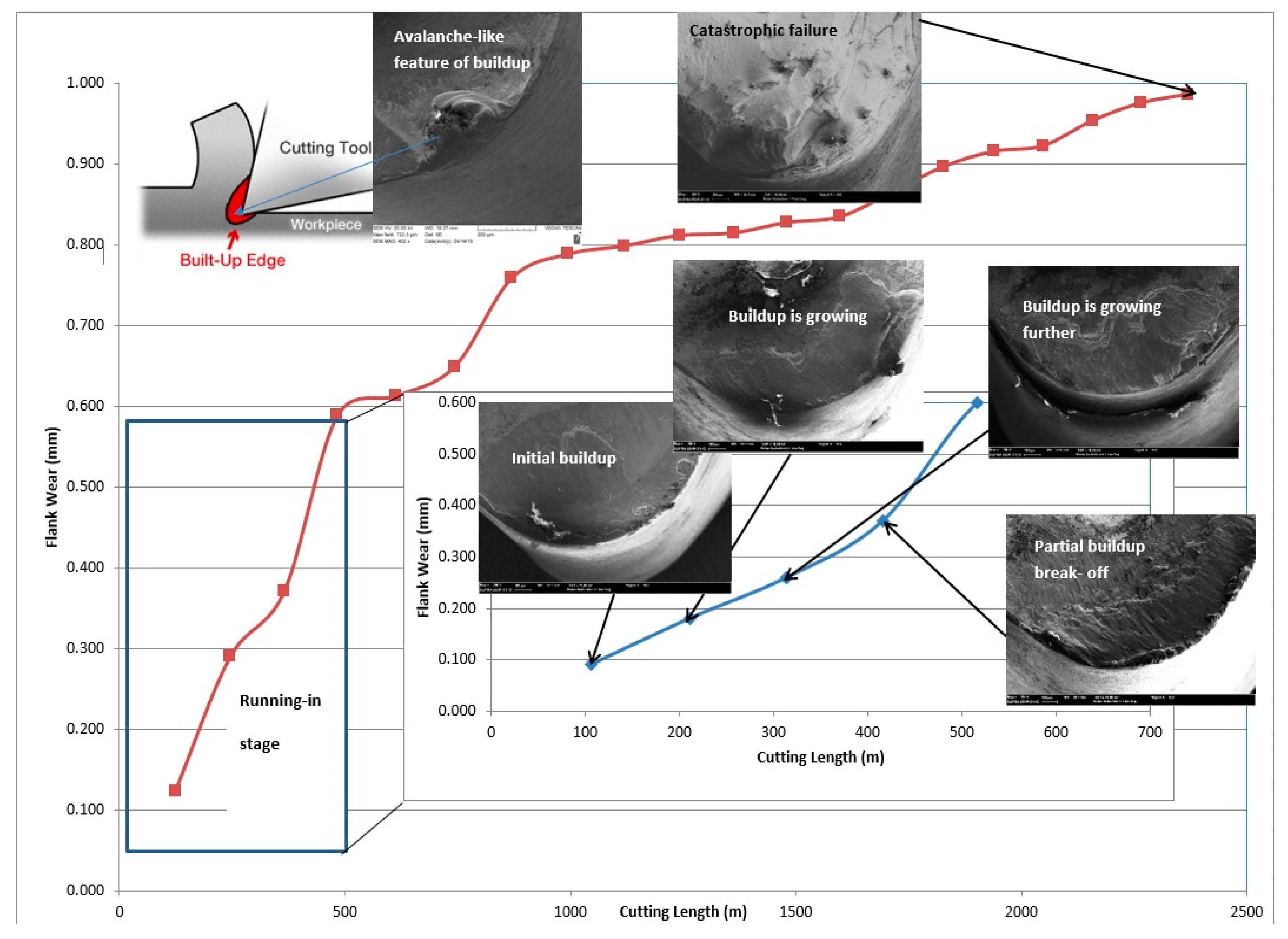
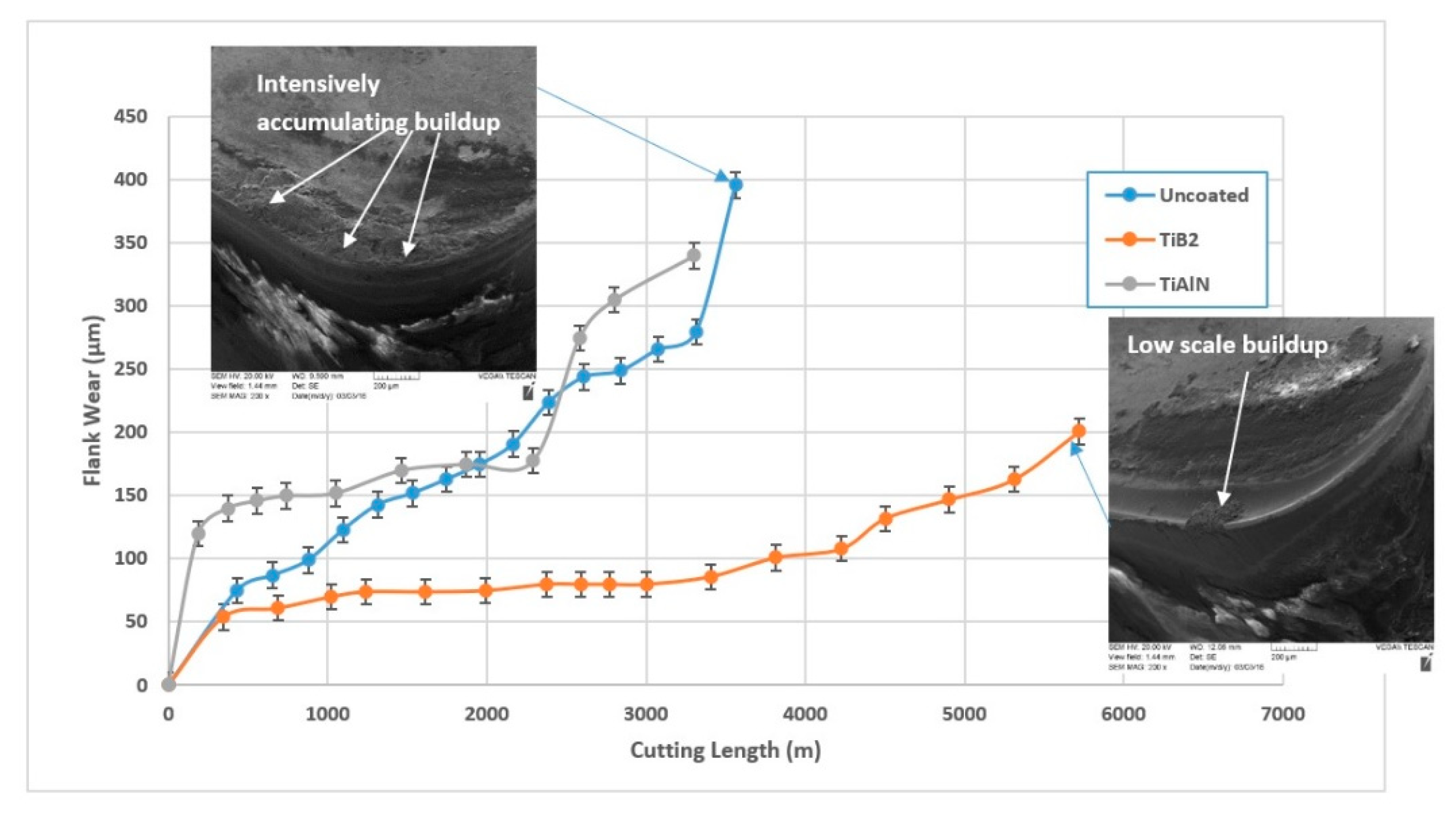
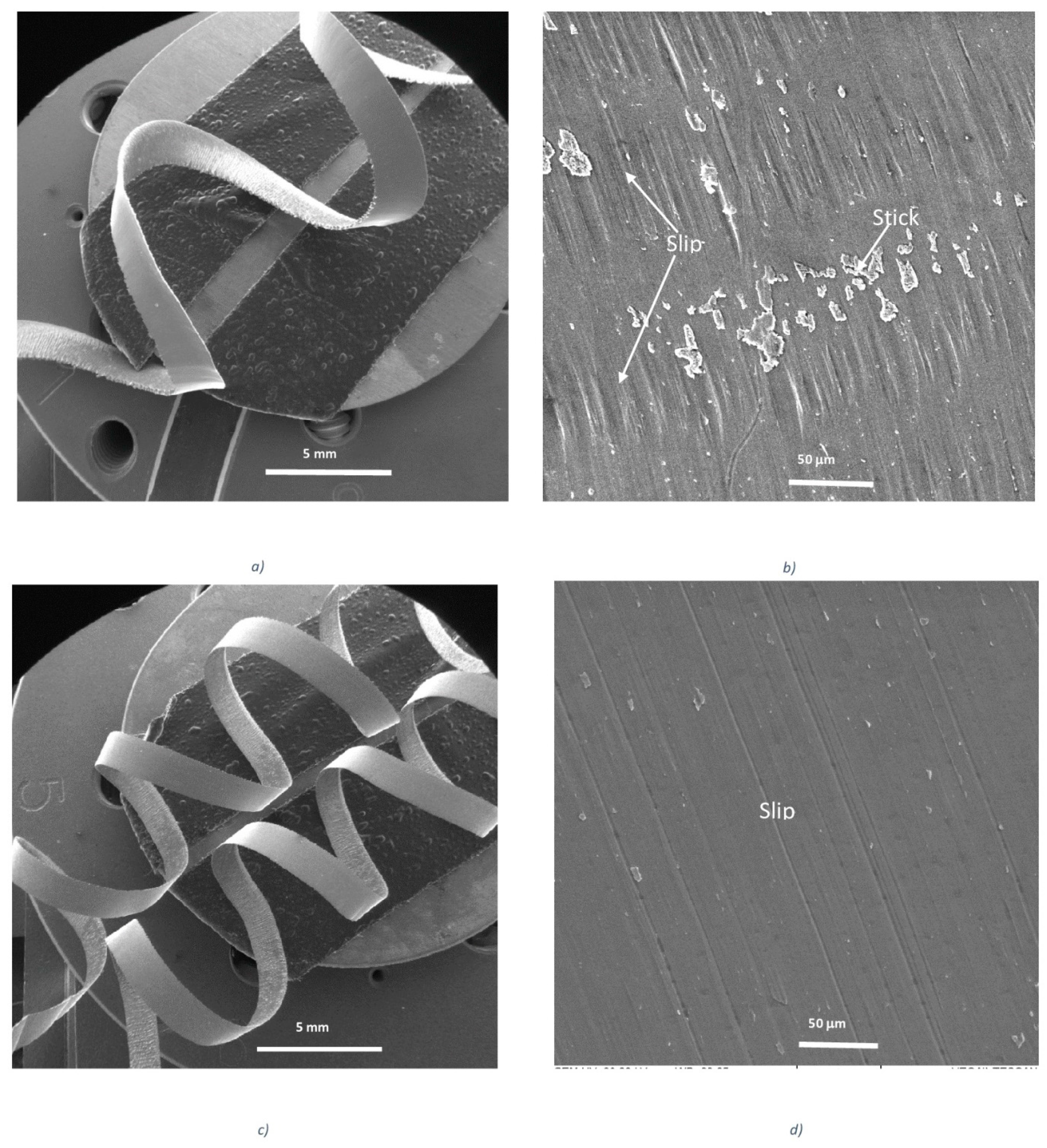

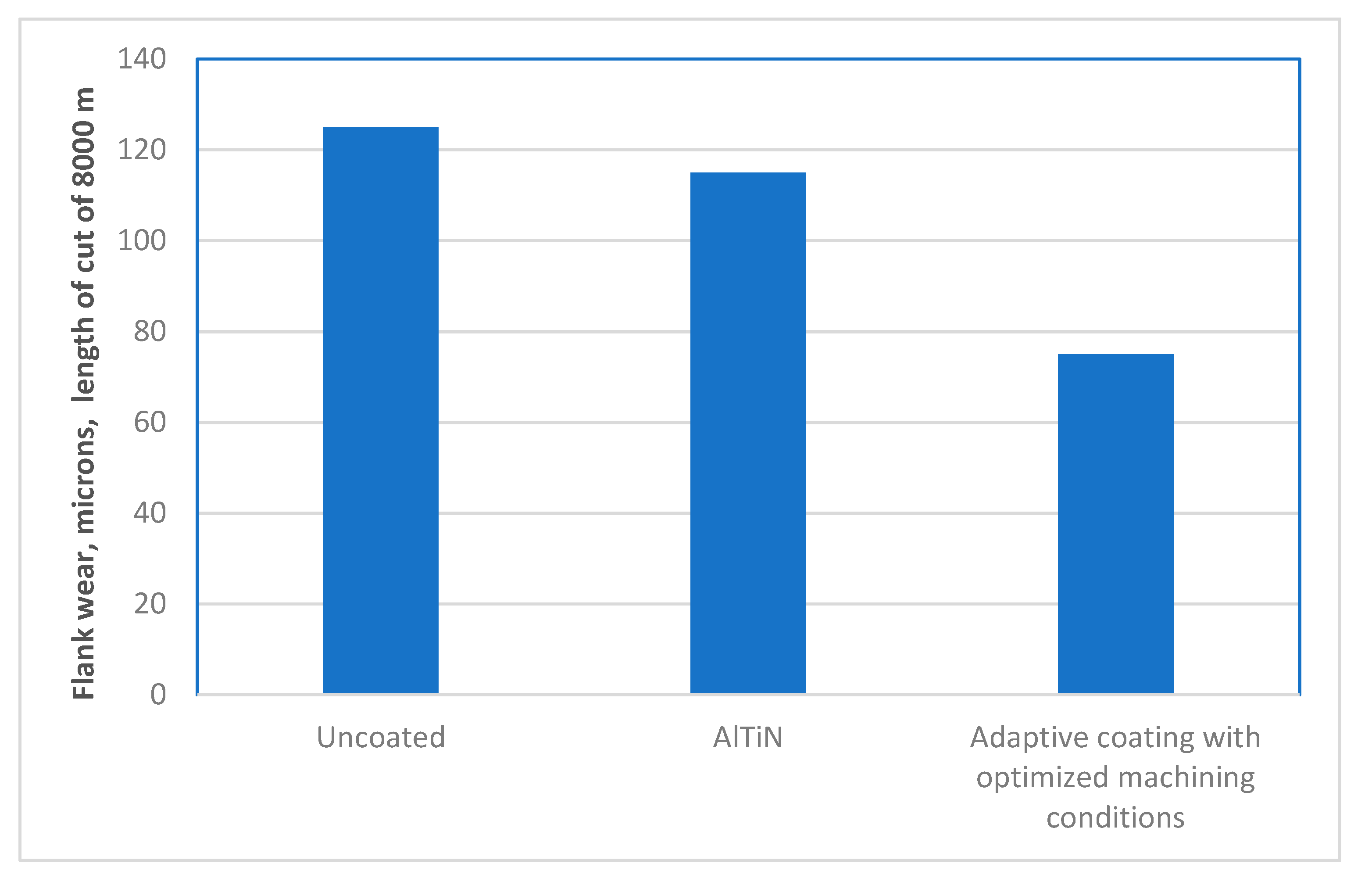
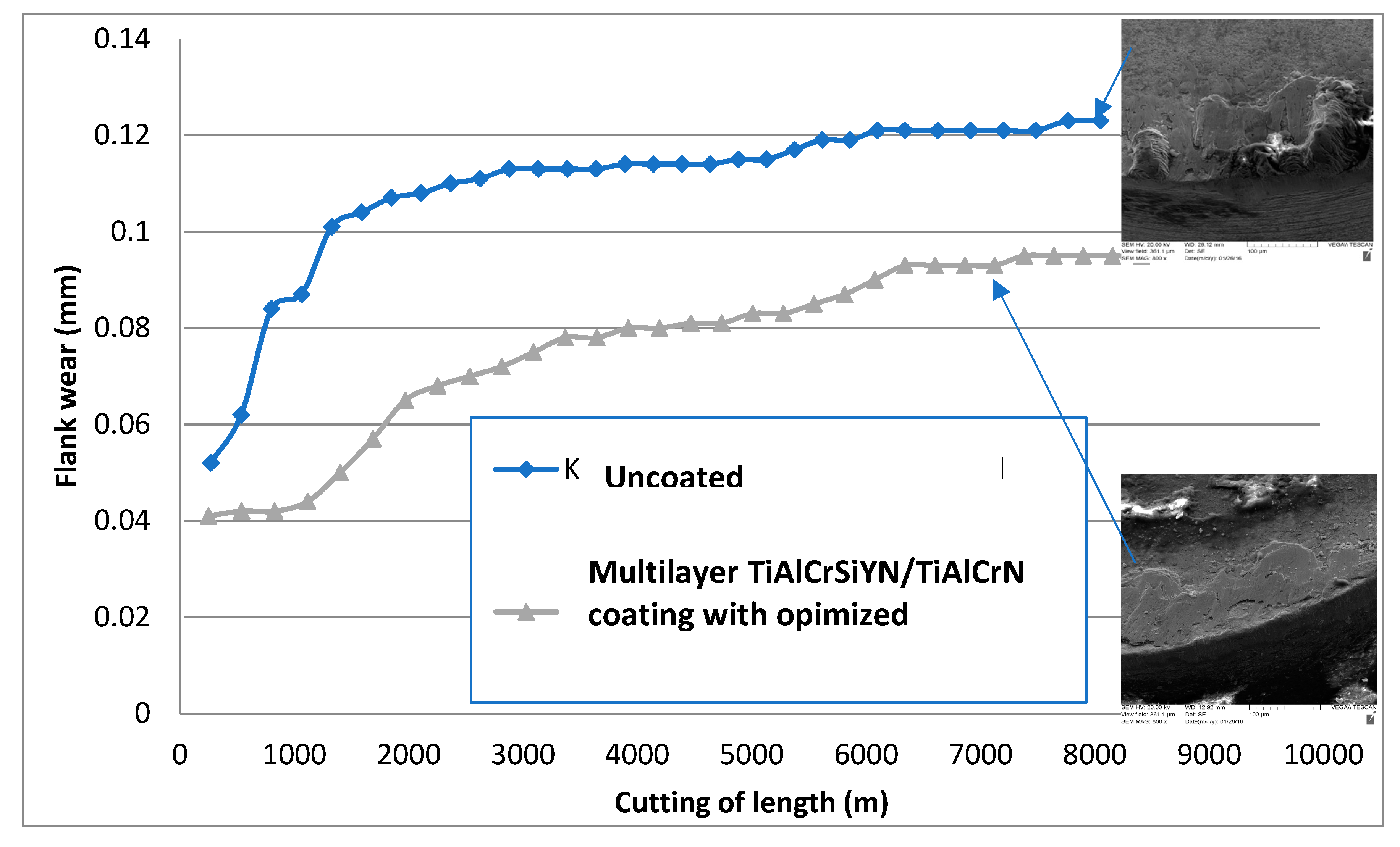


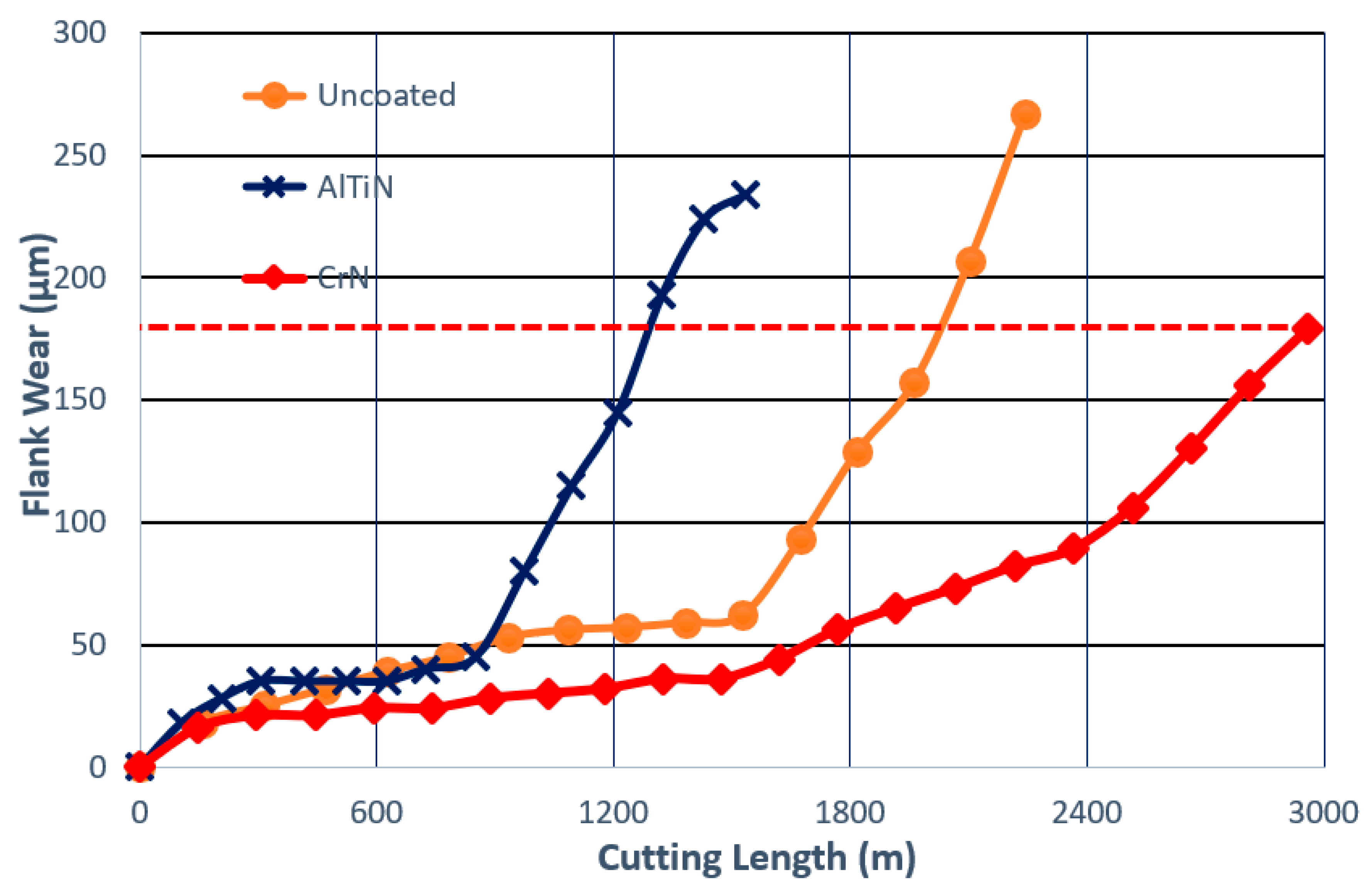
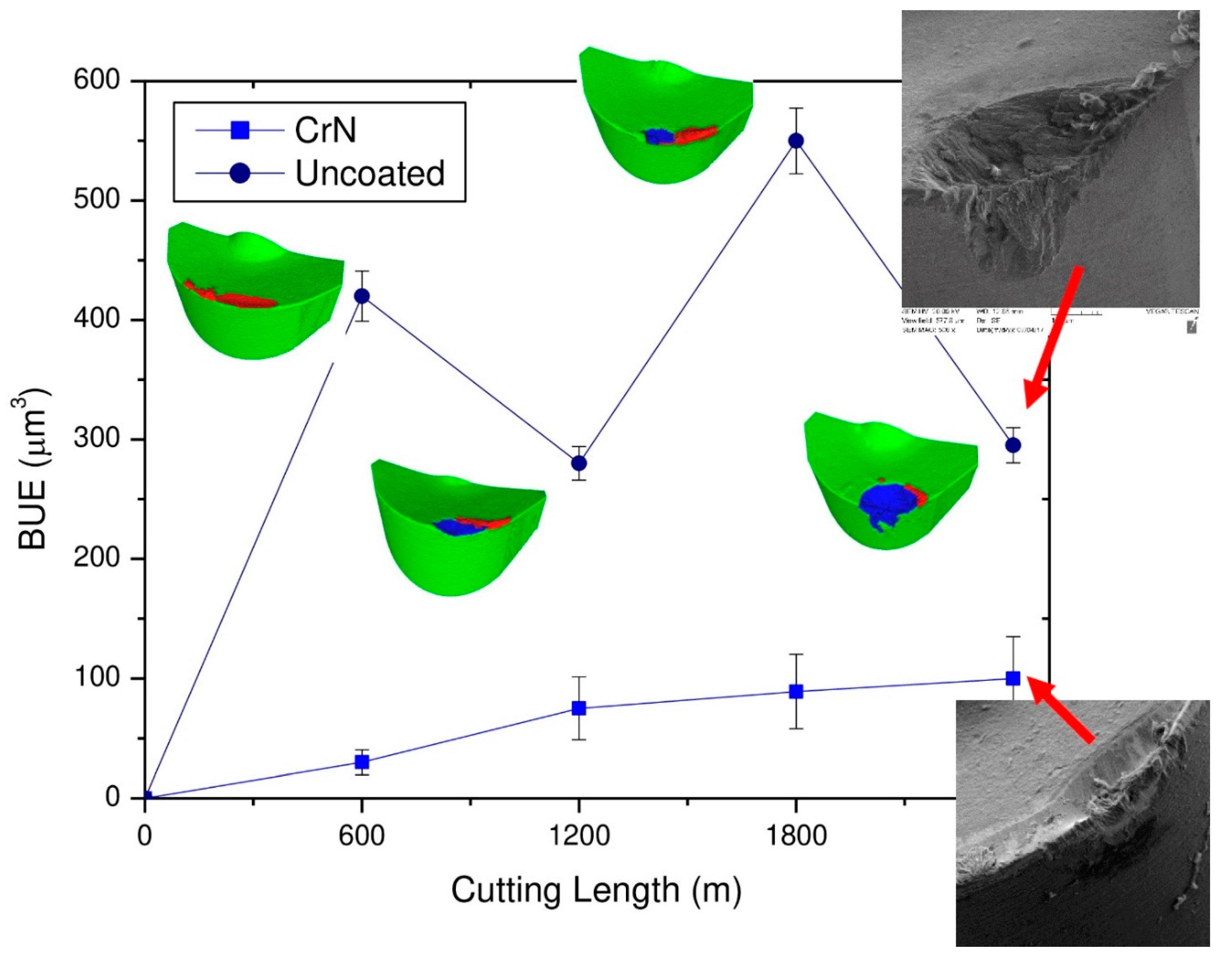

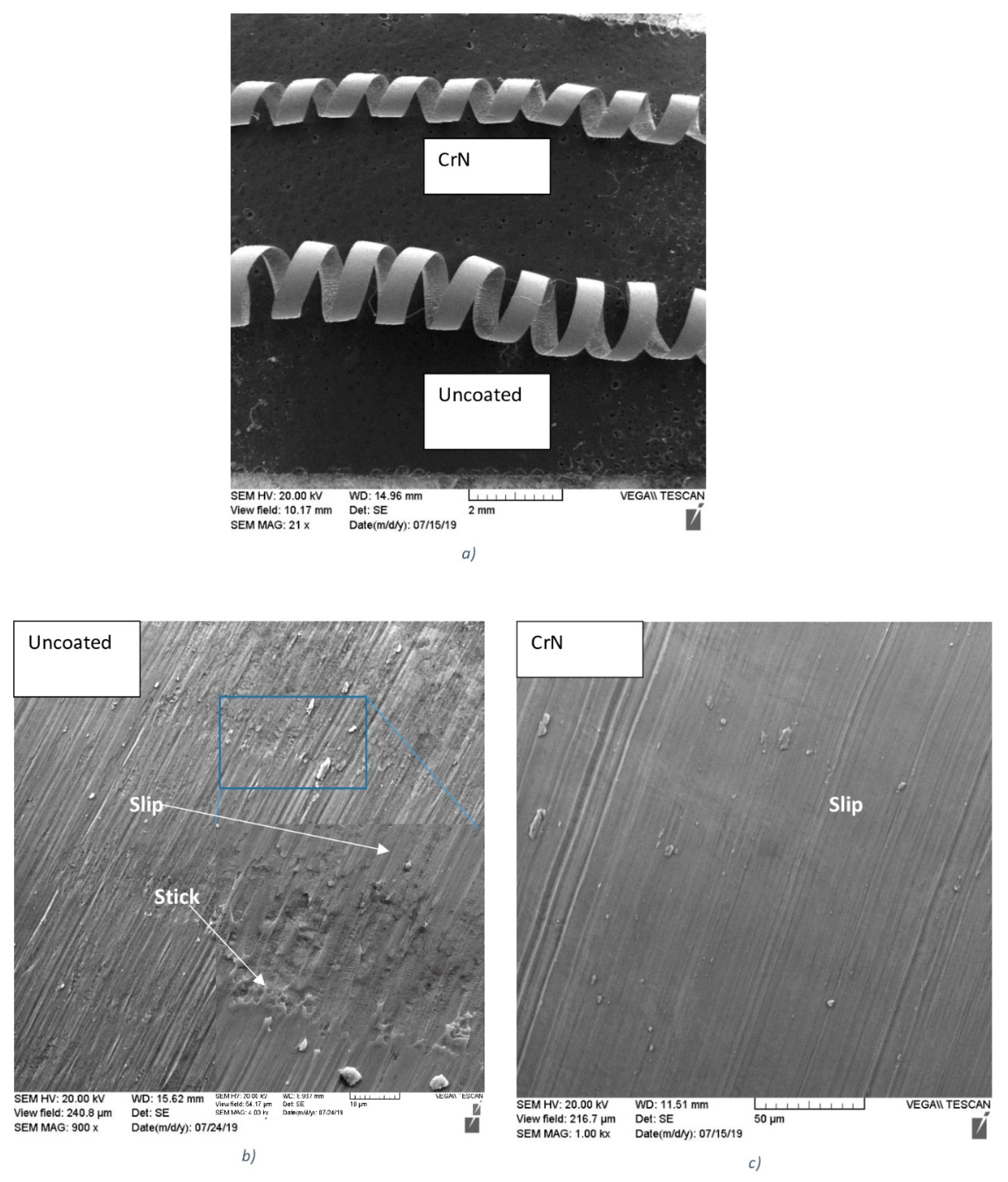
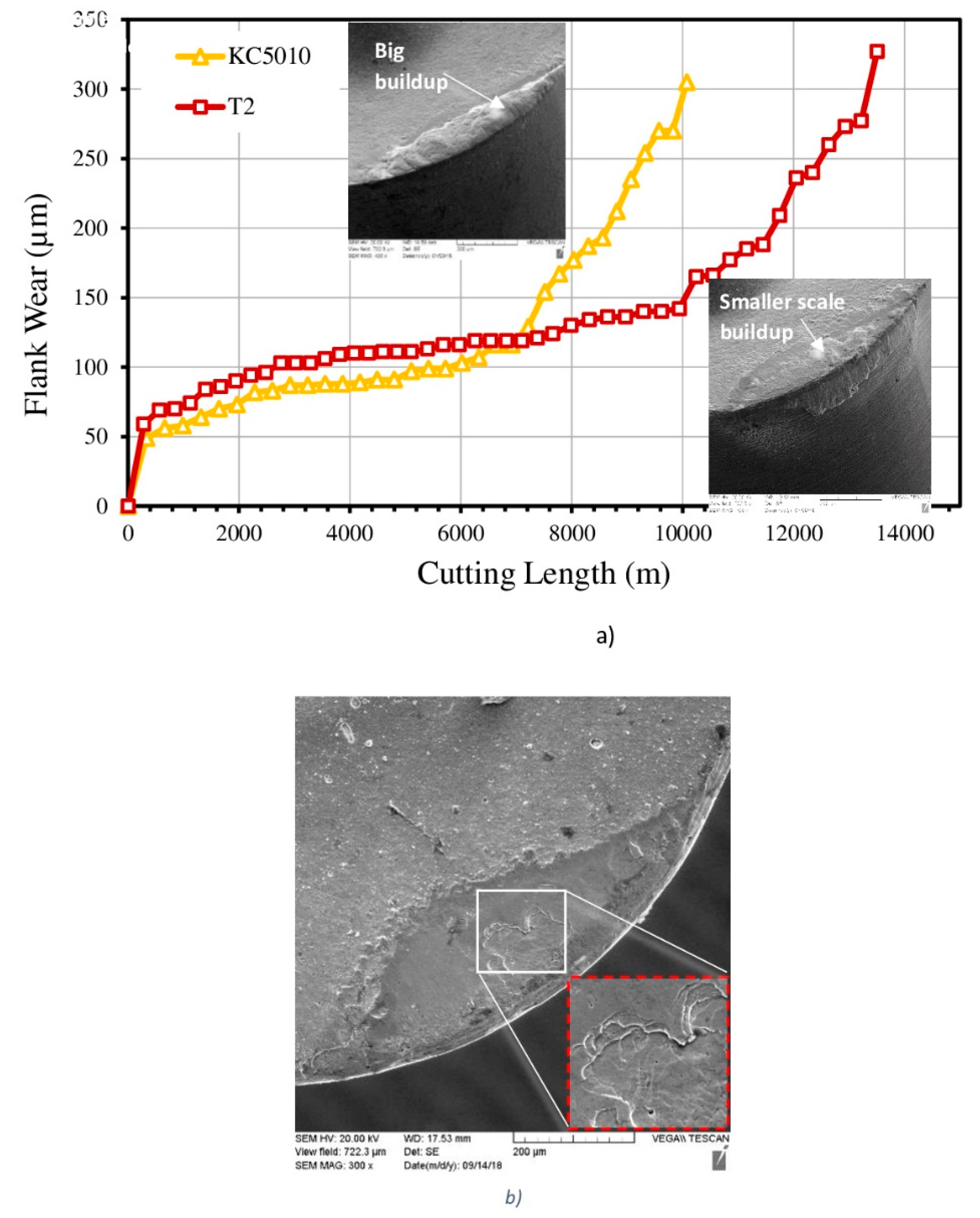
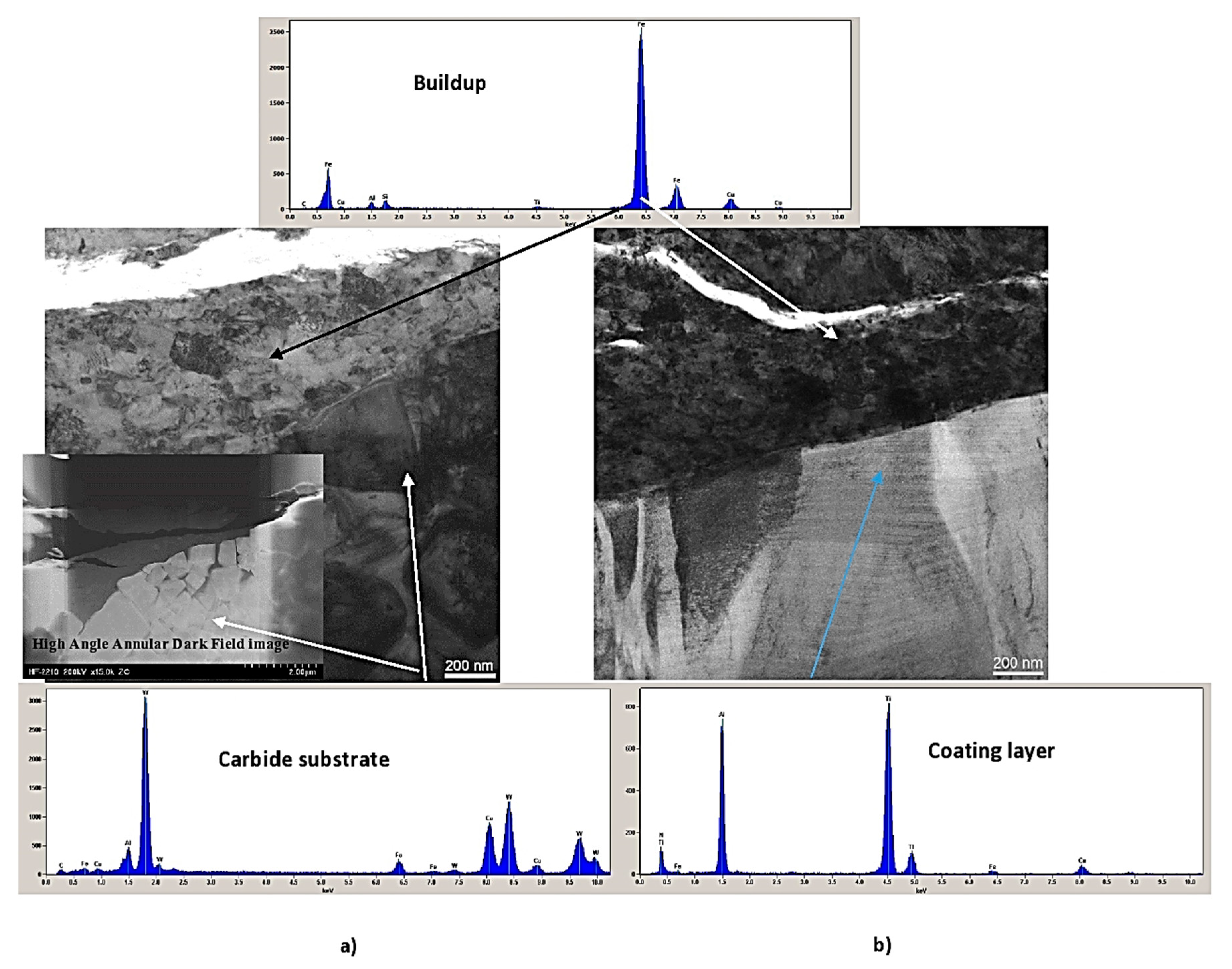
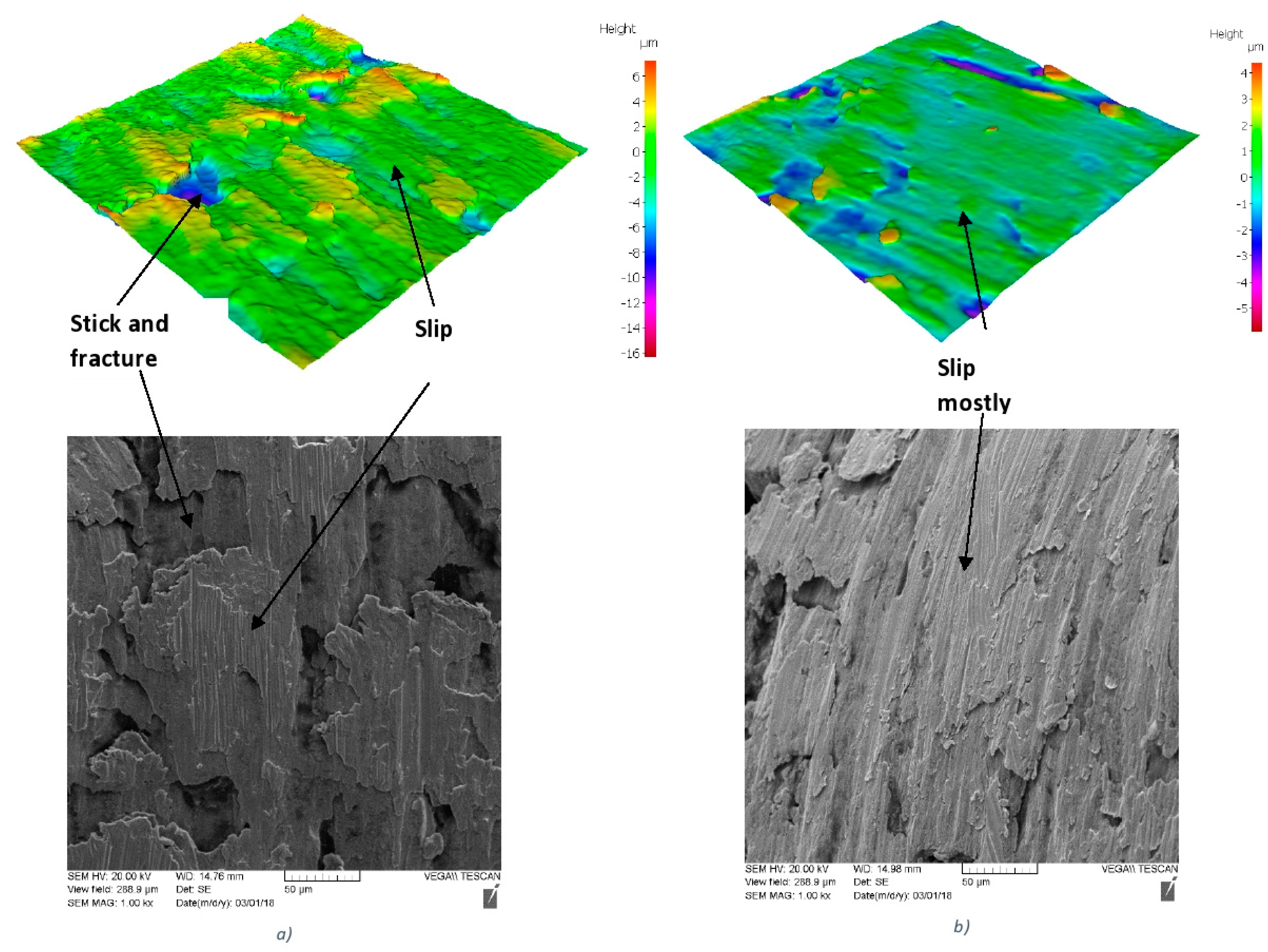
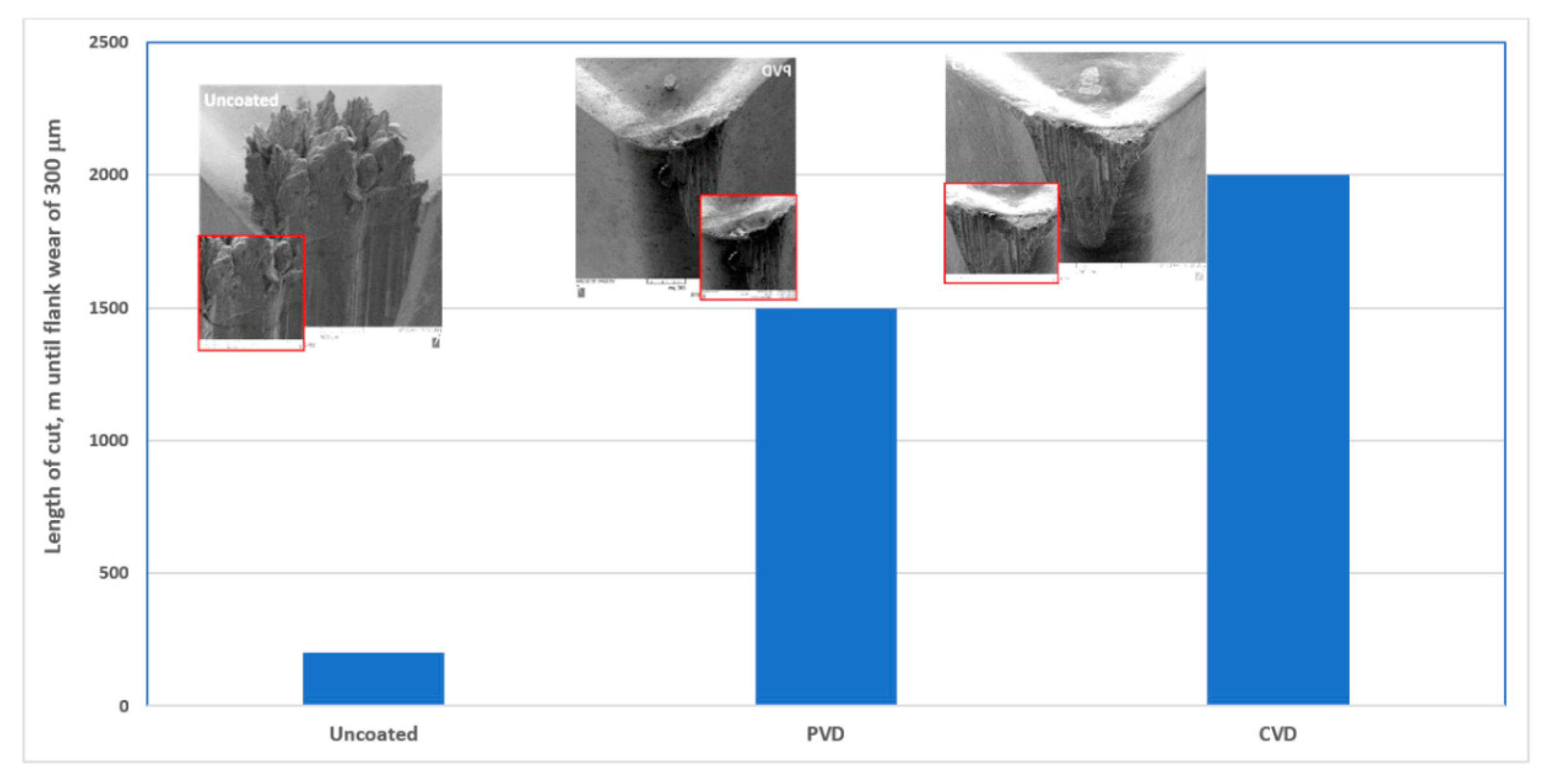

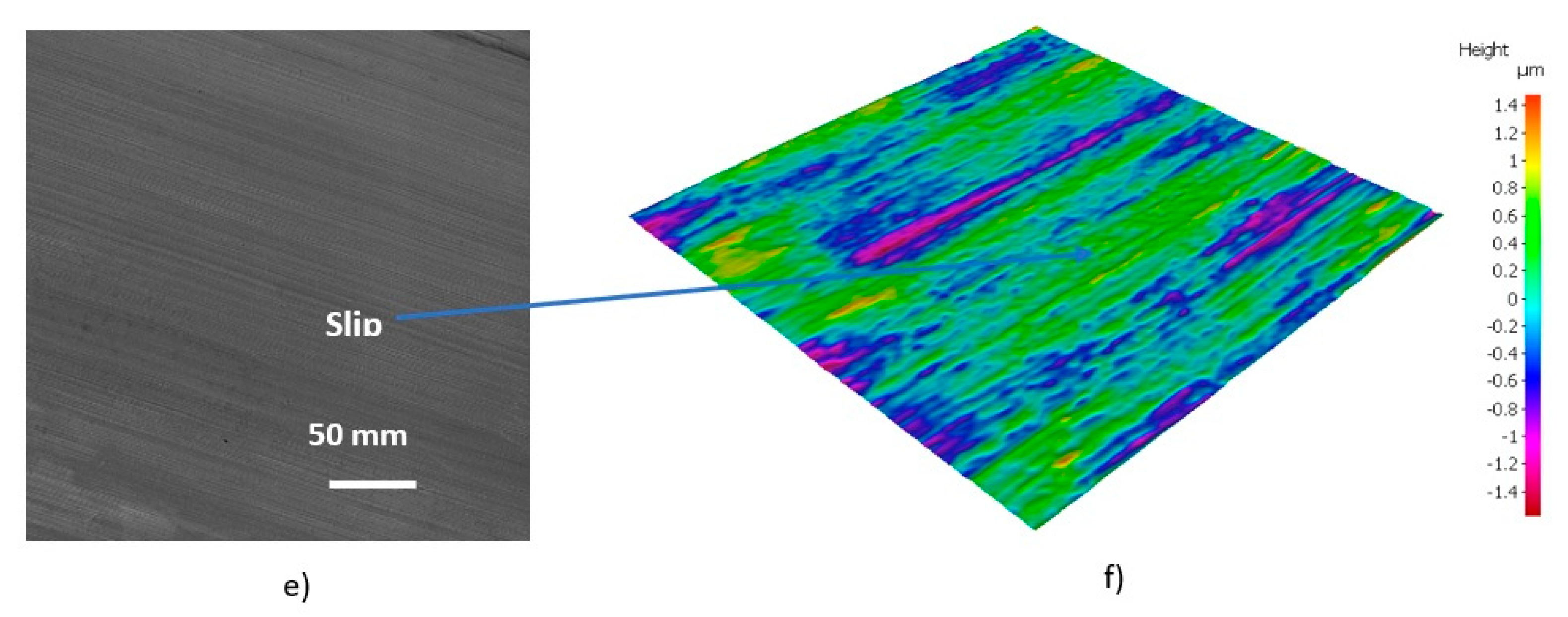
| Coated Carbide Tool Material | Chemical Composition, Wt.% | Structural Characteristics | Hardness, GPa | Elastic Modulus, GPa | H/E | Plasticity Index (PI) | Fracture Toughness, N/μm (Load 100 N) |
|---|---|---|---|---|---|---|---|
| Physical vapor deposition (PVD) coated | |||||||
| Carbide substrate material | WC-92.5 Co-7.5 | Fine-grained cemented carbide | 22.6 | 550 | 0.0414 | 0.635 | |
| Coating layer | Al60Ti40N | Nano-crystalline | 30 | 360 | 0.083 | 1.35 | |
| Chemical vapor deposition (CVD) coated | |||||||
| Carbide substrate material | WC-87.3 Co-10 TiC-2.7 | Medium-grained cemented carbide | 16.8 | 538.7 | 0.0325 | 0.692 | |
| Bi-layer coating: | Al2O3 top layer TiCN sublayer | 33 30 | 390 420 | 0.085 0.071 | 2.0 | ||
Publisher’s Note: MDPI stays neutral with regard to jurisdictional claims in published maps and institutional affiliations. |
© 2020 by the authors. Licensee MDPI, Basel, Switzerland. This article is an open access article distributed under the terms and conditions of the Creative Commons Attribution (CC BY) license (http://creativecommons.org/licenses/by/4.0/).
Share and Cite
Fox-Rabinovich, G.; Gershman, I.S.; Yamamoto, K.; Dosbaeva, J.; Veldhuis, S. Effect of the Adaptive Response on the Wear Behavior of PVD and CVD Coated Cutting Tools during Machining with Built Up Edge Formation. Nanomaterials 2020, 10, 2489. https://doi.org/10.3390/nano10122489
Fox-Rabinovich G, Gershman IS, Yamamoto K, Dosbaeva J, Veldhuis S. Effect of the Adaptive Response on the Wear Behavior of PVD and CVD Coated Cutting Tools during Machining with Built Up Edge Formation. Nanomaterials. 2020; 10(12):2489. https://doi.org/10.3390/nano10122489
Chicago/Turabian StyleFox-Rabinovich, German, Iosif S. Gershman, Kenji Yamamoto, Julia Dosbaeva, and Stephen Veldhuis. 2020. "Effect of the Adaptive Response on the Wear Behavior of PVD and CVD Coated Cutting Tools during Machining with Built Up Edge Formation" Nanomaterials 10, no. 12: 2489. https://doi.org/10.3390/nano10122489
APA StyleFox-Rabinovich, G., Gershman, I. S., Yamamoto, K., Dosbaeva, J., & Veldhuis, S. (2020). Effect of the Adaptive Response on the Wear Behavior of PVD and CVD Coated Cutting Tools during Machining with Built Up Edge Formation. Nanomaterials, 10(12), 2489. https://doi.org/10.3390/nano10122489







